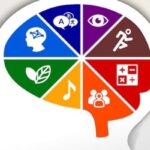We explain what naturalistic intelligence is, what its characteristics are and how to develop it. Also, other types of intelligence.

What is naturalistic intelligence?
Naturalistic intelligence is ability to distinguish, manipulate, interpret and communicate information related to humans and nature In this type of intelligence, the predisposition to explore the natural world and to learn about plants and animals stands out, as well as the ability to formulate hypotheses and seek explanations for natural phenomena.
According to the theory of multiple intelligences proposed in 1983 by the American psychologist Howard Gardner (1943), Intelligences are the abilities that all people have to learn, solve problems or find innovative solutions In principle, Gardner described seven types of intelligence: linguistic, musical, logical-mathematical, kinesthetic-bodily, spatial, interpersonal and intrapersonal.
Later, in 1995, he added naturalistic intelligence to highlight human sensitivities regarding nature and its dynamics, animals and the people. The characteristics attributed to this model of intelligence were previously assigned to logical-mathematical or visual-spatial intelligence, but later they seemed solid enough to propose a specific type of intelligence.
Key points
- Naturalistic intelligence is the ability to identify, classify, relate and manipulate information or elements of the natural environment.
- People with naturalistic intelligence demonstrate a great interest in nature, are able to observe their surroundings and can process the information they receive effectively.
- Some professions associated with this type of intelligence are those related to biology, meteorology, agronomy, veterinary medicine and gardening.
- To develop naturalistic intelligence, it is recommended to carry out activities such as observing nature, caring for plants and animals, or practicing exercises to improve observation of the environment.
Characteristics of people with naturalistic intelligence

Howard Gardner states that naturalistic intelligence has its origins in the needs related to the survival of early humans, such as the recognition of climatic conditions or food resources. Currently, manifests itself in a person's sensitivity to their environment which may or may not be rural, and in the interest in recognizing the forces that human beings cannot control.
In general, people with high naturalistic intelligence are characterized by:
- Recognize patterns around you and make predictions. For example, anticipating the weather.
- Make comparisons and formulate hypotheses about natural phenomena.
- Be curious about the environment and its components.
- Observe, select relevant information about the natural world and classify it.
- Recognize animals, plants and elements of nature, differentiating them from other similar ones.
Examples of naturalistic intelligence
Naturalistic intelligence can be observed in people who show a connection with nature For example, those who are dedicated to caring for the environment, enjoy outdoor activities or can easily identify different species of the same animal.
On the other hand, it is common to observe a high naturalistic intelligence in professions related to biology, meteorology, agronomy, veterinary medicine or gardening among others. That is, it is present in all those occupations that involve the observation of the environment or the species that comprise it.
Some historical figures who manifested naturalistic intelligence were Alexander von Humboldt (geographer), Charles Darwin (biologist and geologist), and Rachel Carlson (marine biologist), whose observations of nature answered many fundamental questions of humanity.
Activities to develop naturalistic intelligence

Some simple activities to develop this type of intelligence are:
- Observation. Take field trips and trips to other types of landscapes, paying attention to their characteristics, similarities and differences.
- Education. Search for information and learn about topics such as living beings, the environment and the evolution of species.
- Gardening. Get involved in activities related to caring for plants or a garden.
- Mindfulness . Practice mindfulness exercises, which allow you to develop the ability to observe the environment.
- Pet care. Caring for an animal at home or collaborating in the care of animals at a shelter.
- Photography or drawing. Capture natural scenes through photos or drawings, to appreciate and discover their details.
Other types of intelligence
The other types of intelligence that are part of Gardner's theory of multiple intelligences are:
- Linguistic intelligence . It is the ability to acquire and use oral or written language effectively.
- musical intelligence It is the ability to perceive, appreciate and express rhythmic patterns and musical forms.
- Logical-mathematical intelligence. It is the ability to use numbers to solve problems and think logically.
- Kinesthetic-body intelligence. It is the ability to handle tools related to body movement and touch.
- Spatial intelligence . It is the ability to perceive and understand spaces, such as the perception of the size of objects and proportions.
- Interpersonal intelligence . It is the ability to understand and relate to other people, through communication and empathy.
- intrapersonal intelligence . It is the ability to know oneself and understand one's own emotions and motivations.
document.addEventListener(“DOMContentLoaded”, (e) => { var sliderContainer, slider; sliderContainer = document.getElementById(‘block_6aed2cffb25916bee79230c942daf8aa’); if (typeof initSlider !== ‘function’) { console.log(‘Swiper haven\’t been loaded’); sliderContainer.className += ‘ fw scroll-snap’; return; }; options = { direction: ‘horizontal’, speed: 1000, slidesPerView: ‘auto’, // slidesPerGroup: 1, centerInsufficientSlides: true, // centeredSlides:true, spaceBetween: 15, breakpoints: { 720: { // centeredSlides: false, // slidesPerGroup: 2, spaceBetween: 25 }, }, pagination: { el: ‘.swiper-pagination’, type: ‘bullets’, clickable: true }, } slider = initSlider(sliderContainer, options); })
References
- Gardner, H. (2001). Intelligence reformulated. Multiple intelligences in the 21st century. Paidós.
- Martín Carrasquilla, O. (2014). Naturalistic intelligence: A magnifying glass to discover life. Education and Future(31), 163-190. https://cesdonbosco.com





